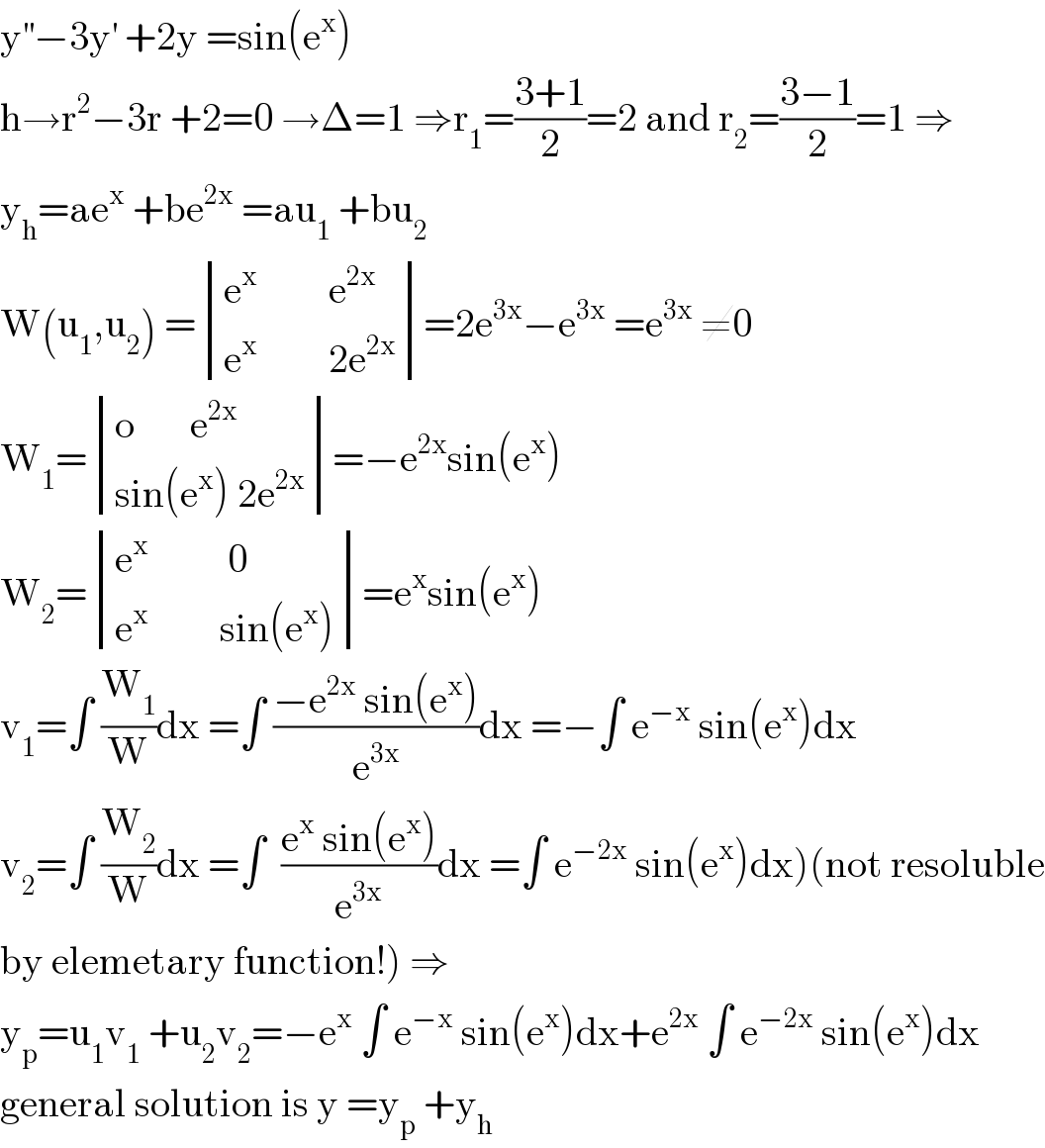
Question Number 126524 by rs4089 last updated on 21/Dec/20

Answered by Olaf last updated on 21/Dec/20
![Let u = e^x (dy/dx) = (dy/du).(du/dx) = e^x (dy/du) = u(dy/du) (d^2 y/dx^2 ) = (d/dx)((du/dx)) = (d/du)(u(du/du))(du/dx) (d^2 y/dx^2 ) = u[u(d^2 y/du^2 )+(dy/du)] (D^2 −3D+2)y = sin(e^x ) u^2 (d^2 y/du^2 )−2u(dy/du)+2y = sinu u^2 (d^3 y/du^3 )+2u(d^2 y/du^2 )−2u(d^2 y/du^2 )−2(dy/du)+2(dy/du) = cosu (d^3 y/du^3 ) = ((cosu)/u^2 ) (d^2 y/du^2 ) = ∫((cosu)/u^2 )du = −((cosu)/u)−Si(u)+C_1 (dy/du) = −Ci(u)−uSi(u)−cosu+C_1 u+C_2 y = −(uCi(u)−sinu) −(1/2)(u^2 Si(u)−sinu+ucosu)−sinu +(1/2)C_1 u^2 +C_2 u+C_3 y = −(1/2)u^2 Si(u)−uCi(u)−(1/2)ucosu+(1/2)sinu +au^2 +bu+c y = −(1/2)e^(2x) Si(e^x )−e^x Ci(e^x )−(1/2)e^x cos(e^x )+(1/2)sin(e^x ) +ae^(2x) +be^x +c](Q126527.png)
$$\mathrm{Let}\:{u}\:=\:{e}^{{x}} \\ $$$$\frac{{dy}}{{dx}}\:=\:\frac{{dy}}{{du}}.\frac{{du}}{{dx}}\:=\:{e}^{{x}} \frac{{dy}}{{du}}\:=\:{u}\frac{{dy}}{{du}} \\ $$$$\frac{{d}^{\mathrm{2}} {y}}{{dx}^{\mathrm{2}} }\:=\:\frac{{d}}{{dx}}\left(\frac{{du}}{{dx}}\right)\:=\:\frac{{d}}{{du}}\left({u}\frac{{du}}{{du}}\right)\frac{{du}}{{dx}} \\ $$$$\frac{{d}^{\mathrm{2}} {y}}{{dx}^{\mathrm{2}} }\:=\:{u}\left[{u}\frac{{d}^{\mathrm{2}} {y}}{{du}^{\mathrm{2}} }+\frac{{dy}}{{du}}\right] \\ $$$$ \\ $$$$\left({D}^{\mathrm{2}} −\mathrm{3}{D}+\mathrm{2}\right){y}\:=\:\mathrm{sin}\left({e}^{{x}} \right) \\ $$$${u}^{\mathrm{2}} \frac{{d}^{\mathrm{2}} {y}}{{du}^{\mathrm{2}} }−\mathrm{2}{u}\frac{{dy}}{{du}}+\mathrm{2}{y}\:=\:\mathrm{sin}{u} \\ $$$${u}^{\mathrm{2}} \frac{{d}^{\mathrm{3}} {y}}{{du}^{\mathrm{3}} }+\mathrm{2}{u}\frac{{d}^{\mathrm{2}} {y}}{{du}^{\mathrm{2}} }−\mathrm{2}{u}\frac{{d}^{\mathrm{2}} {y}}{{du}^{\mathrm{2}} }−\mathrm{2}\frac{{dy}}{{du}}+\mathrm{2}\frac{{dy}}{{du}}\:=\:\mathrm{cos}{u} \\ $$$$\frac{{d}^{\mathrm{3}} {y}}{{du}^{\mathrm{3}} }\:=\:\frac{\mathrm{cos}{u}}{{u}^{\mathrm{2}} } \\ $$$$\frac{{d}^{\mathrm{2}} {y}}{{du}^{\mathrm{2}} }\:=\:\int\frac{\mathrm{cos}{u}}{{u}^{\mathrm{2}} }{du}\:=\:−\frac{\mathrm{cos}{u}}{{u}}−\mathrm{Si}\left({u}\right)+\mathrm{C}_{\mathrm{1}} \\ $$$$\frac{{dy}}{{du}}\:=\:−\mathrm{Ci}\left({u}\right)−{u}\mathrm{Si}\left({u}\right)−\mathrm{cos}{u}+\mathrm{C}_{\mathrm{1}} {u}+\mathrm{C}_{\mathrm{2}} \\ $$$${y}\:=\:−\left({u}\mathrm{Ci}\left({u}\right)−\mathrm{sin}{u}\right) \\ $$$$−\frac{\mathrm{1}}{\mathrm{2}}\left({u}^{\mathrm{2}} \mathrm{Si}\left({u}\right)−\mathrm{sin}{u}+{u}\mathrm{cos}{u}\right)−\mathrm{sin}{u} \\ $$$$+\frac{\mathrm{1}}{\mathrm{2}}\mathrm{C}_{\mathrm{1}} {u}^{\mathrm{2}} +\mathrm{C}_{\mathrm{2}} {u}+\mathrm{C}_{\mathrm{3}} \\ $$$$ \\ $$$${y}\:=\:−\frac{\mathrm{1}}{\mathrm{2}}{u}^{\mathrm{2}} \mathrm{Si}\left({u}\right)−{u}\mathrm{Ci}\left({u}\right)−\frac{\mathrm{1}}{\mathrm{2}}{u}\mathrm{cos}{u}+\frac{\mathrm{1}}{\mathrm{2}}\mathrm{sin}{u} \\ $$$$+{au}^{\mathrm{2}} +{bu}+{c} \\ $$$$ \\ $$$${y}\:=\:−\frac{\mathrm{1}}{\mathrm{2}}{e}^{\mathrm{2}{x}} \mathrm{Si}\left({e}^{{x}} \right)−{e}^{{x}} \mathrm{Ci}\left({e}^{{x}} \right)−\frac{\mathrm{1}}{\mathrm{2}}{e}^{{x}} \mathrm{cos}\left({e}^{{x}} \right)+\frac{\mathrm{1}}{\mathrm{2}}\mathrm{sin}\left({e}^{{x}} \right) \\ $$$$+{ae}^{\mathrm{2}{x}} \:+{be}^{{x}} +{c} \\ $$
Answered by mathmax by abdo last updated on 22/Dec/20

$$\mathrm{y}^{''} −\mathrm{3y}^{'} \:+\mathrm{2y}\:=\mathrm{sin}\left(\mathrm{e}^{\mathrm{x}} \right) \\ $$$$\mathrm{h}\rightarrow\mathrm{r}^{\mathrm{2}} −\mathrm{3r}\:+\mathrm{2}=\mathrm{0}\:\rightarrow\Delta=\mathrm{1}\:\Rightarrow\mathrm{r}_{\mathrm{1}} =\frac{\mathrm{3}+\mathrm{1}}{\mathrm{2}}=\mathrm{2}\:\mathrm{and}\:\mathrm{r}_{\mathrm{2}} =\frac{\mathrm{3}−\mathrm{1}}{\mathrm{2}}=\mathrm{1}\:\Rightarrow \\ $$$$\mathrm{y}_{\mathrm{h}} =\mathrm{ae}^{\mathrm{x}} \:+\mathrm{be}^{\mathrm{2x}} \:=\mathrm{au}_{\mathrm{1}} \:+\mathrm{bu}_{\mathrm{2}} \\ $$$$\mathrm{W}\left(\mathrm{u}_{\mathrm{1}} ,\mathrm{u}_{\mathrm{2}} \right)\:=\begin{vmatrix}{\mathrm{e}^{\mathrm{x}} \:\:\:\:\:\:\:\:\:\mathrm{e}^{\mathrm{2x}} }\\{\mathrm{e}^{\mathrm{x}} \:\:\:\:\:\:\:\:\:\mathrm{2e}^{\mathrm{2x}} }\end{vmatrix}=\mathrm{2e}^{\mathrm{3x}} −\mathrm{e}^{\mathrm{3x}} \:=\mathrm{e}^{\mathrm{3x}} \:\neq\mathrm{0} \\ $$$$\mathrm{W}_{\mathrm{1}} =\begin{vmatrix}{\mathrm{o}\:\:\:\:\:\:\:\mathrm{e}^{\mathrm{2x}} }\\{\mathrm{sin}\left(\mathrm{e}^{\mathrm{x}} \right)\:\mathrm{2e}^{\mathrm{2x}} }\end{vmatrix}=−\mathrm{e}^{\mathrm{2x}} \mathrm{sin}\left(\mathrm{e}^{\mathrm{x}} \right) \\ $$$$\mathrm{W}_{\mathrm{2}} =\begin{vmatrix}{\mathrm{e}^{\mathrm{x}} \:\:\:\:\:\:\:\:\:\:\mathrm{0}}\\{\mathrm{e}^{\mathrm{x}} \:\:\:\:\:\:\:\:\:\mathrm{sin}\left(\mathrm{e}^{\mathrm{x}} \right)}\end{vmatrix}=\mathrm{e}^{\mathrm{x}} \mathrm{sin}\left(\mathrm{e}^{\mathrm{x}} \right) \\ $$$$\mathrm{v}_{\mathrm{1}} =\int\:\frac{\mathrm{W}_{\mathrm{1}} }{\mathrm{W}}\mathrm{dx}\:=\int\:\frac{−\mathrm{e}^{\mathrm{2x}} \:\mathrm{sin}\left(\mathrm{e}^{\mathrm{x}} \right)}{\mathrm{e}^{\mathrm{3x}} }\mathrm{dx}\:=−\int\:\mathrm{e}^{−\mathrm{x}} \:\mathrm{sin}\left(\mathrm{e}^{\mathrm{x}} \right)\mathrm{dx} \\ $$$$\left.\mathrm{v}_{\mathrm{2}} =\int\:\frac{\mathrm{W}_{\mathrm{2}} }{\mathrm{W}}\mathrm{dx}\:=\int\:\:\frac{\mathrm{e}^{\mathrm{x}} \:\mathrm{sin}\left(\mathrm{e}^{\mathrm{x}} \right)}{\mathrm{e}^{\mathrm{3x}} }\mathrm{dx}\:=\int\:\mathrm{e}^{−\mathrm{2x}} \:\mathrm{sin}\left(\mathrm{e}^{\mathrm{x}} \right)\mathrm{dx}\right)\left(\mathrm{not}\:\mathrm{resoluble}\right. \\ $$$$\left.\mathrm{by}\:\mathrm{elemetary}\:\mathrm{function}!\right)\:\Rightarrow \\ $$$$\mathrm{y}_{\mathrm{p}} =\mathrm{u}_{\mathrm{1}} \mathrm{v}_{\mathrm{1}} \:+\mathrm{u}_{\mathrm{2}} \mathrm{v}_{\mathrm{2}} =−\mathrm{e}^{\mathrm{x}} \:\int\:\mathrm{e}^{−\mathrm{x}} \:\mathrm{sin}\left(\mathrm{e}^{\mathrm{x}} \right)\mathrm{dx}+\mathrm{e}^{\mathrm{2x}} \:\int\:\mathrm{e}^{−\mathrm{2x}} \:\mathrm{sin}\left(\mathrm{e}^{\mathrm{x}} \right)\mathrm{dx} \\ $$$$\mathrm{general}\:\mathrm{solution}\:\mathrm{is}\:\mathrm{y}\:=\mathrm{y}_{\mathrm{p}} \:+\mathrm{y}_{\mathrm{h}} \\ $$
